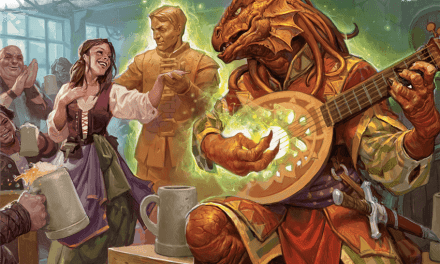Few things in the world are as certain as a change, and few know this as well as Transmutation Wizards!
These spellcasters focus heavily on providing utility by changing the physical form and properties of things around them.
In this way, Transmutation Wizards are able to rebuild the world around them in a way that they see fit.
Do you dare to harness this power for yourself?
Now is your chance!
This is the full guide to the Transmutation Wizard in D&D 5e!
What is the Transmutation Wizard in D&D 5e?
The school of Transmutation prizes using magic for utility in solving problems. In a way, it’s arguably the most practical school of magic for this!
While any Wizard can learn Transmutation spells, Transmutation Wizards specialize in it and can bring out even more interesting ways to use it.
This ranges from unique alchemical effects to shapechanging to creating a Transmuter’s Stone that is capable of providing several unique benefits to its wielder.
Some Transmutation Wizards specialize in this school as a way to gain a deeper understanding of the world around them. With a careful scientific approach, they poke and prod to see how the laws of nature can be bent and manipulated.
Others might be drawn to this school of magic for more unscrupulous reasons. Promises of being able to turn mundane materials into gold or to stay forever young are certainly tempting!
There is an undeniable amount of power and potential within the school of Transmutation. The question is if you’re willing to put in the work required to unlock such mysteries!
The Transmutation Wizard is one of eight Wizard subclasses that appear in the 5e Player’s Handbook.
Role in the Party
All Wizards are certainly capable of many important roles in a party and the Transmutation Wizard is no exception.
Whether you need some huge blasting arcane artillery or some magical utility and problem-solving, Wizards are ready to shine.
But it’s the utility and problem-solving area that Transmutation magic particularly focuses on.
After all, this is the school of magic that allows you to do things like increase a creature’s running/jumping abilities, slowing falls, making people fly, and other such awesome effects!
Because of that, there’s a big focus on creativity when you’re focusing on using transmutation magic.
Sure, you’ll still be doing your fair share of blasting. However, you’re especially valuable in those situations where utility and problem-solving are needed more than lobbing fireballs at things.
(Because, yes, such situations do exist!)
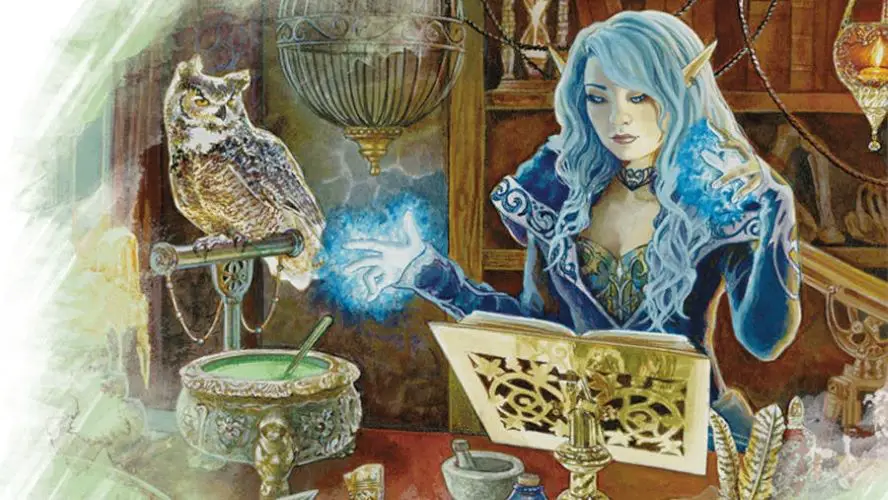
Transmutation Wizard Features 5e
Transmutation Wizards have dedicated their lives to the study of arcane magic but specialize in the school of Transmutation.
Because they have such a deep understanding of this magic and its power, they’re capable of more powerful Transmutation magic than other Wizards.
This is reflected in the Transmutation Wizard’s class features.
Let’s dive in!
You Might Like: The Schools of Magic in D&D 5e Explained
Transmutation Savant (Level 2)
We kick things off with a feature that is shared by all of the Wizard subclasses in the PHB.
As a specialist in Transmutation magic, you’re more efficient when it comes to adding Transmutation spells to your spellbook.
The gold and time you must spend to copy a Transmutation spell into your spellbook is halved.
As a Wizard, your spellbook is your single most important possession. You will constantly be looking to learn new spells and add them to your precious spellbook.
Of course, this does take time, money, and a bit of luck when you’re looking for specific spells to copy into your book.
Thankfully, the time and gold cost for copying Transmutation spells is cut in half for you!
Note that you’re not only limited to learning Transmutation spells. In fact, it’s still a very good idea to pick up some standbys like Fireball or Misty Step for when it’s time for action.
I strongly recommend checking out my article that covers using and managing the Wizard’s spellbook in more detail to help you with this. It’s quite literally the most important thing for any Wizard to know.
Minor Alchemy (Level 2)
The first unique feature that the Transmutation Wizard gets is Minor Alchemy.
Considering that transmutation magic is all about changing the properties and nature of matter, it’s fitting.
You perform a special alchemical procedure on one object composed entirely of wood, stone (but not a gemstone), iron, copper, or silver, transforming it into a different one of those materials.
For every 10 minutes you spend performing the procedure, you can transform up to 1 cubic foot of material.
After 1 hour, or until you lose your concentration (as if you were concentrating on a spell), the material reverts to its original substance.
Fitting? Yes.
Useful? Well… it depends…
Maybe you can turn the iron latch of a locked door or a jail cell into wood so your Barbarian can smash through it.
If you’re of questionable ethics, you could turn some trash into silver and con some poor merchant if you plan on being out of town within the hour. (Though you’ll likely not be doing business with that merchant again in the future without the use of a disguise.)
Either way, you’re spending 10 minutes for every 1 cubic foot of material.
This can be used for some creative problem-solving. However, you’re going to need to also have the time to use this as well.
If you need to transform 6 cubic feet of material into something else, you’re going to run into a situation where the first batch is reverting to its original form as you finish transforming the sixth batch.
There’s some situational use to this feature, but it’s not really worth doing a happy dance about.

Transmuter’s Stone (Level 6)
At level 6 we finally get the Transmutation Wizard’s most important feature: their Transmuter’s Stone.
This handy stone is capable of giving you your choice of several different buffs.
Alternatively, you can give the stone to one of your allies, and they can receive the buff!
You can spend 8 hours creating a Transmuter’s Stone that stores transmutation magic.
You can benefit from the stone yourself or give it to another creature. A creature gains a benefit of your choice as long as the stone is in the creature’s possession.
Each time you cast a transmutation spell of level 1 or higher, you can change the effect of your stone if the stone is on your person.
If you create a new transmuter’s stone, the previous one ceases to function.
Alright, so you’re going to spend the better part of a day creating this stone. Still, it’s worth taking a day off from adventuring to make it!
From there, be aware that you can change the effect each time you cast any transmutation spell as long as that spell is at least level 1. (Just note that the stone has to be in your possession to do so.)
As for the unique benefits that you can choose, you’ve got four options.
Let’s check them out!
Gain darkvision out to a range of 60 feet.
This option is somewhat useful.
Most races in D&D 5e start with Darkvision, but this can be handy if you are playing something like a Human, Halfling, or Dragonborn that doesn’t.
Of course, there’s also always the Darkvision spell.
Gain an increase to speed of 10 feet while the creature is unencumbered.
Extra speed can be handy.
Of course, this is especially handy if you’re giving it to your party’s Rogue or Monk who tend to benefit the most from high mobility when skirmishing in combat.
Gain proficiency in Constitution saving throws.
In my opinion, the extra buff to your Constitution saving throws is the best option. This is because that buff will directly help you maintain concentration on spells if you get hit.
If you’re feeling nice, giving this buff to your Cleric or Druid (both of which have a lot of impactful concentration spells) will certainly be appreciated.
Gain resistance to acid, cold, fire, lightning, or thunder damage (your choice whenever you choose this benefit)
If you know that enemies ahead favor a certain damage type and you expect to get hit with any frequency, this might be worth picking.
But ideally, you aren’t in the habit of getting hit. When those moments do happen, look to spells like Absorb Elements or Protection from Energy.
Of course, having one of your frontline allies hold onto your stone is a solid idea. If you’re charging into an evil temple in the heart of a volcano, they would certainly appreciate some fire resistance!
Shapechanger (Level 10)
There’s most certainly some wonderful utility to being able to change your form. Just ask literally any Druid!
Sneaking through small spaces as a mouse or flying as a giant owl can offer some great utility and scouting potential.
You add the Polymorph spell to your spellbook if it is not there already. You can cast Polymorph without expending a spell slot.
When you do so, you can target only yourself and transform into a beast whose challenge rating is 1 or lower.
Once you cast Polymorph in this way, you can’t do so again until you finish a short or long rest, though you can still cast it normally using an available spell slot.
This is…
Uh…
Well, it’s certainly something…
The problem here (and somewhat of a trap) is that Shapechanger is most certainly not an arcane alternative to the Druid’s Wild Shape feature.
The biggest risk here is that, unlike when a Druid uses Wild Shape, Polymorph affects both your physical and mental stats.
In other words, if you turn into a mouse, you are both physically and mentally a mouse. This means that your scouting mission can get immediately derailed by a piece of cheese.
Funny as that is, it’s less funny when you realize that this is a level 10 feature…
Save scouting for your Rogue or Monk. Maybe even use some Divination magic!
If you’re trying to use this offensively, maybe you could turn into a bear or something in combat and still focus on your enemies.
That should work, right?
But what if you lose concentration on Polymorph or get turned back into your regular squishy Wizard form? Now you’re on the front lines where you simply don’t belong.
My two cents: save the shapechanging for the Druids. They know what they’re doing.
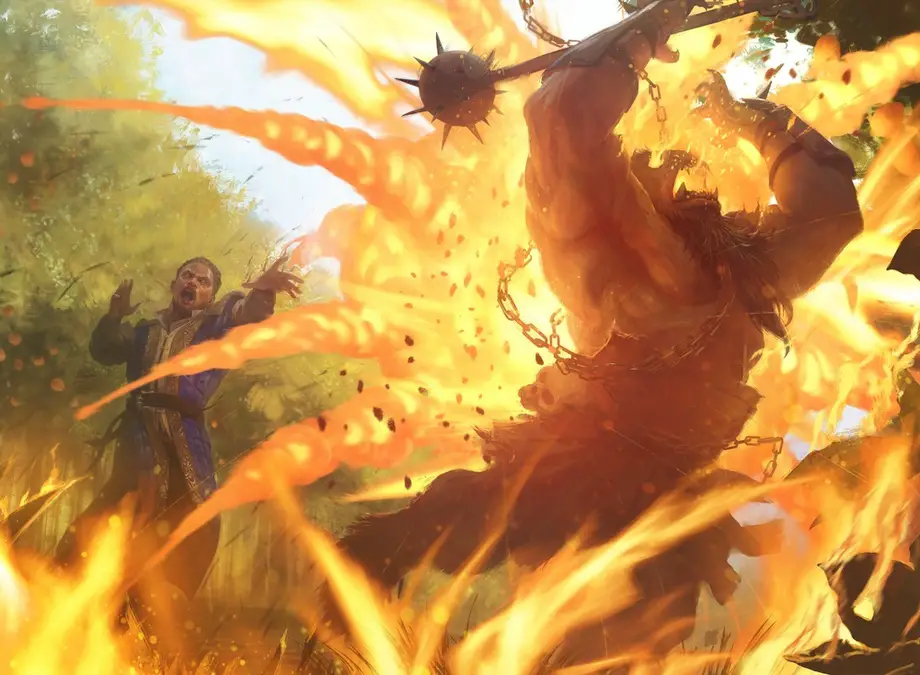
Master Transmuter (Level 14)
We finally come to the Transmutation Wizard’s capstone feature: Master Transmuter.
You can use your action to consume the reserve of transmutation magic stored within your Transmuter’s Stone in a single burst. When you do so, choose one of the following effects.
Your transmuter’s stone is destroyed and can’t be remade until you finish a long rest.
Much like with your Transmuter’s Stone feature, you’ve got several options here.
You will want to choose wisely, though!
Each option destroys your Transmuter’s Stone which means that you’ll be sacrificing whatever buff that has been giving you (or an ally) to produce one of these effects. You won’t be getting that buff back until you spend 8 hours creating a new Transmuter’s Stone.
Major Transformation: You can transmute one nonmagical object – no larger than a 5-foot cube- into another nonmagical object of similar size and mass and of equal or lesser value. You just spend 10 minutes handling the object to transform it.
It’s a bit difficult to make a blanket statement about this feature.
In the right situation and with a lot of creativity, this can be very useful and worth sacrificing your Transmuter’s Stone for.
However, I see those moments being fairly rare.
At level 14, you’ve got a large assortment of spells to choose from that can likely get you out of most situations you find yourself in.
And that’s not even counting your allies’ resources!
I won’t say this is a bad option, but it’s definitely a variable one.
Panacea: You remove all curses, diseases, and poisons affecting a creature that you touch with the transmuter’s stone. The creature also regains all of its hit points.
Probably the best use of the Master Transmuter feature.
Sure, you’ll be spending 8 hours recreating your Transmuter’s Stone, but giving an ally a clean slate and a whole new set of hit points is likely worth it in those clutch moments.
Of course, the worst case is that your ally is riddled with all manner of curses, poisons, and maybe even a disease or two all while being at death’s door. In those cases, Panacea is awesome.
The jury’s out if you’re using it to treat a single affliction, though.
Use your best judgment.
Restore Life: You can the Raise Dead spell on a creature you touch with the Transmuter’s Stone, without expending a spell slot or needing to have the spell in your spellbook.
In situations where you want to save your Cleric’s spell slot, this could be decent to have.
Even still, just be mindful that a creature that you raise with Raise Dead will be facing a stark penalty to all of their ability scores for the next 4 days.
Restore Youth: You touch the transmuter’s stone to a willing creature, and that creature’s apparent age is reduced by 3d10 years, to a minimum of 13 years. This effect doesn’t extend the creature’s life span.
This is fun, I suppose, but not particularly useful. You’re not making somebody younger so much as you’re just making them seem that way.
Your capstone feature is way better spent on something other than Fantasy Botox.
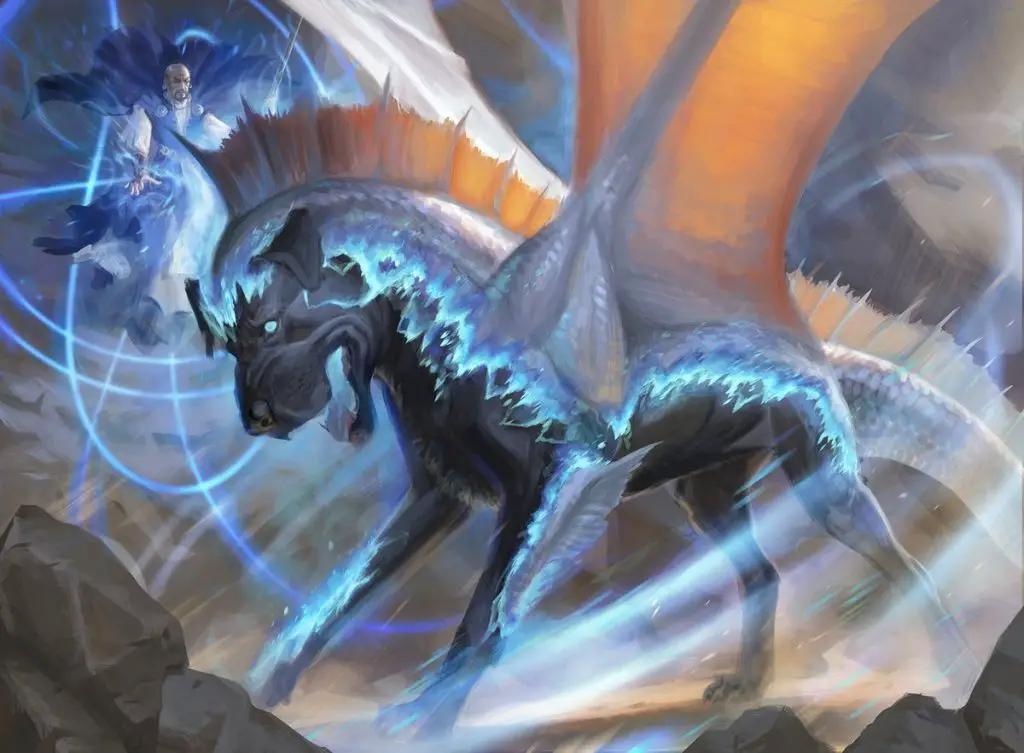
Connections
So how do you connect your Transmutation Wizard to your game’s world?
Because each Wizard subclass is directly related to what they have spent countless hours over many years studying, that’s always a great place to start.
Personally, I imagine Transmutation Wizards as very detail-oriented people who are excellent and pragmatic thinkers. Much like engineers in the real world, a lot about their personalities is said by their ability to solve problems.
To that end, I imagine studying Transmutation magic to be similarly detailed. Lots of theories, complex mathematical equations, and basically everything else that I was horrible at in school.
It seems to fit.
So, in connecting your Transmutation Wizard to the game, consider what drove your character to specialize in this school of magic. What clues does that give about their personality?
Of course, you can also latch onto the idea of “change” that is so important to this school.
Is there something big that the character wants to change in the world or possibly even within/about themselves?
Whether you’ve mastered Transmutation theories in the halls of a prestigious arcane academy or have had plenty of practical application on the streets, what does this power actually mean to you?
Is the Transmutation Wizard Good?
Hahahaha!
No.
I have tried so hard to find truly redeeming qualities to the Transmutation Wizard in D&D 5e. But I’ve given up.
Anything that these Wizards can do that’s useful can be done just as easily by any other Wizard.
Minor Alchemy is incredibly situational to the point that it’s more of a flavorful “ribbon” feature than anything. Shapechanger is a useless and botched attempt to emulate the Druid’s Wild Shape feature.
I’m a bit kinder to the Transmuter’s Stone and Master Transmuter features, but even still, they’re situational.
If you just need the Constitution bonus from the Transmuter’s Stone, consider taking the Resilient feat.
Honestly, my chief gripe with the Transmutation Wizard is that every other Wizard subclass that specializes in a specific school of magic gains new, interesting, and exclusive ways to use that magic.
This isn’t the case with the Transmutation Wizard.
Any Wizard can cast Transmutation spells. Furthermore, because the Transmutation Wizard doesn’t get any new ways to use those spells, any Wizard can cast Transmutation spells just as well as a Transmutation Wizard.
But, hey, at least the Transmutation Wizard gets a rock.
Recommended: Ranking Every Wizard Subclass in D&D 5e!
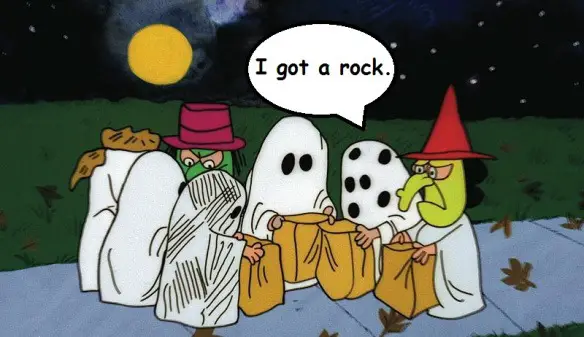
Conclusion – Transmutation Wizard in D&D 5e
I hope you’ve found this guide to the Transmutation Wizard in D&D 5e helpful!
There’s a lot of potential here and it’s a subclass that I have nearly played countless times. However, the question still remains: what can the Transmutation Wizard ACTUALLY do that others can’t?
As much as I hate to bash on any subclass, this one just doesn’t cut the mustard when compared to other options like the Divination Wizard or the Evocation Wizard.
But, as always, that’s just my opinion.
I’m curious to read your thoughts on the Transmutation Wizard in D&D 5e.
Let’s chat in the comments below!






